instrument panel Lancia Delta 2010 Owner handbook (in English)
[x] Cancel search | Manufacturer: LANCIA, Model Year: 2010, Model line: Delta, Model: Lancia Delta 2010Pages: 276, PDF Size: 5.31 MB
Page 64 of 276
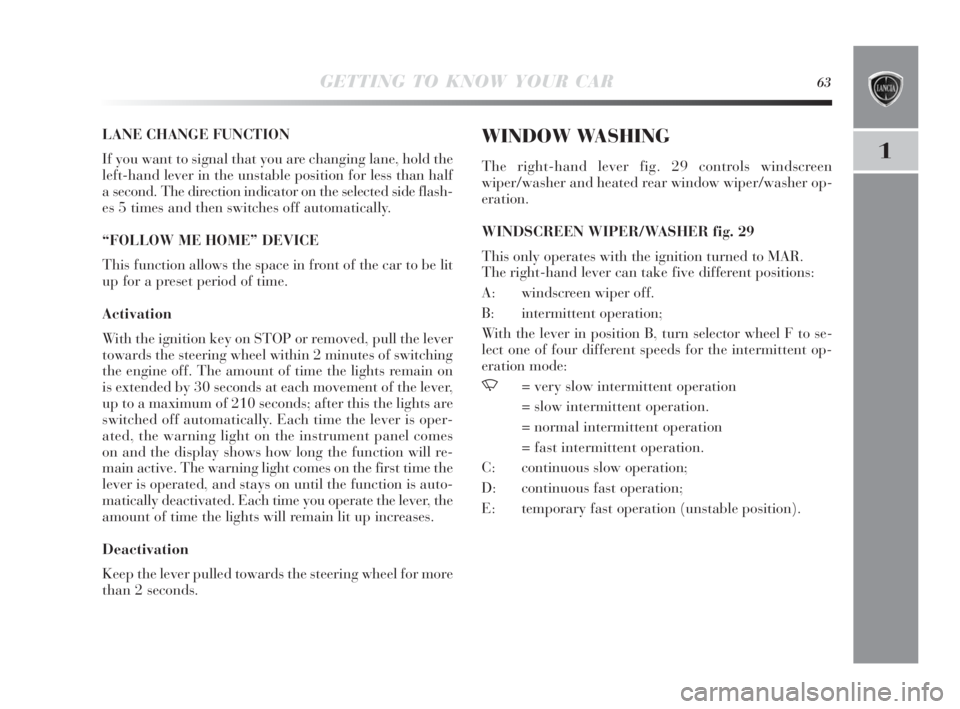
GETTING TO KNOW YOUR CAR63
1
LANE CHANGE FUNCTION
If you want to signal that you are changing lane, hold the
left-hand lever in the unstable position for less than half
a second. The direction indicator on the selected side flash-
es 5 times and then switches off automatically.
“FOLLOW ME HOME” DEVICE
This function allows the space in front of the car to be lit
up for a preset period of time.
Activation
With the ignition key on STOP or removed, pull the lever
towards the steering wheel within 2 minutes of switching
the engine off. The amount of time the lights remain on
is extended by 30 seconds at each movement of the lever,
up to a maximum of 210 seconds; after this the lights are
switched off automatically. Each time the lever is oper-
ated, the warning light on the instrument panel comes
on and the display shows how long the function will re-
main active. The warning light comes on the first time the
lever is operated, and stays on until the function is auto-
matically deactivated. Each time you operate the lever, the
amount of time the lights will remain lit up increases.
Deactivation
Keep the lever pulled towards the steering wheel for more
than 2 seconds.WINDOW WASHING
The right-hand lever fig. 29 controls windscreen
wiper/washer and heated rear window wiper/washer op-
eration.
WINDSCREEN WIPER/WASHER fig. 29
This only operates with the ignition turned to MAR.
The right-hand lever can take five different positions:
A: windscreen wiper off.
B: intermittent operation;
With the lever in position B, turn selector wheel F to se-
lect one of four different speeds for the intermittent op-
eration mode:
,= very slow intermittent operation
= slow intermittent operation.
= normal intermittent operation
= fast intermittent operation.
C: continuous slow operation;
D: continuous fast operation;
E: temporary fast operation (unstable position).
001-142 Delta 3ed gb 30-11-2009 11:22 Pagina 63
Page 68 of 276
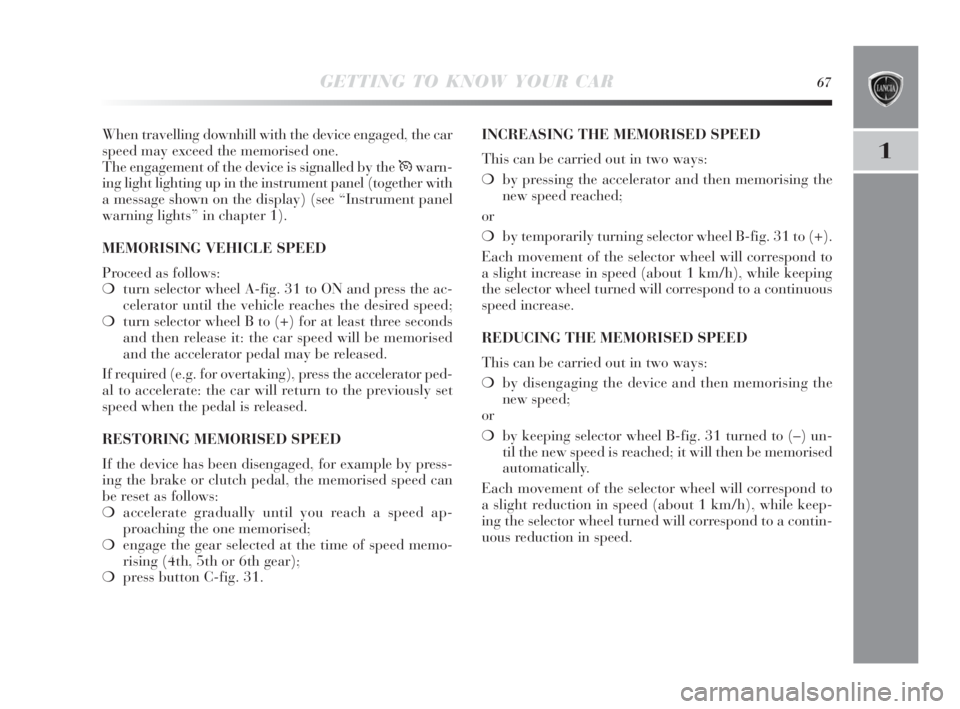
GETTING TO KNOW YOUR CAR67
1
When travelling downhill with the device engaged, the car
speed may exceed the memorised one.
The engagement of the device is signalled by the Üwarn-
ing light lighting up in the instrument panel (together with
a message shown on the display) (see “Instrument panel
warning lights” in chapter 1).
MEMORISING VEHICLE SPEED
Proceed as follows:
❍turn selector wheel A-fig. 31 to ON and press the ac-
celerator until the vehicle reaches the desired speed;
❍turn selector wheel B to (+) for at least three seconds
and then release it: the car speed will be memorised
and the accelerator pedal may be released.
If required (e.g. for overtaking), press the accelerator ped-
al to accelerate: the car will return to the previously set
speed when the pedal is released.
RESTORING MEMORISED SPEED
If the device has been disengaged, for example by press-
ing the brake or clutch pedal, the memorised speed can
be reset as follows:
❍accelerate gradually until you reach a speed ap-
proaching the one memorised;
❍engage the gear selected at the time of speed memo-
rising (4th, 5th or 6th gear);
❍press button C-fig. 31.INCREASING THE MEMORISED SPEED
This can be carried out in two ways:
❍by pressing the accelerator and then memorising the
new speed reached;
or
❍by temporarily turning selector wheel B-fig. 31 to (+).
Each movement of the selector wheel will correspond to
a slight increase in speed (about 1 km/h), while keeping
the selector wheel turned will correspond to a continuous
speed increase.
REDUCING THE MEMORISED SPEED
This can be carried out in two ways:
❍by disengaging the device and then memorising the
new speed;
or
❍by keeping selector wheel B-fig. 31 turned to (–) un-
til the new speed is reached; it will then be memorised
automatically.
Each movement of the selector wheel will correspond to
a slight reduction in speed (about 1 km/h), while keep-
ing the selector wheel turned will correspond to a contin-
uous reduction in speed.
001-142 Delta 3ed gb 30-11-2009 11:22 Pagina 67
Page 72 of 276

GETTING TO KNOW YOUR CAR71
1
When this function is on (see“SPORT function”), the word
SPORT appears on the display. Press the button once again
to deactivate the function and return to the standard dri-
ving mode.
fig. 36L0E0028m
HAZARD WARNING LIGHTS fig. 36
These lights are switched on by pressing switch A, re-
gardless of the position of the ignition key.
Warning lights
Îand¥are lit up on the instrument pan-
el when this device is activated.. To switch off the lights,
press button A once again.
Use of the hazard warning lights is governed by the High-
way Code of the country you are in. Keep to the rules.
Emergency braking
In the event of emergency braking the hazard warning
lights come on automatically, as do the
Îand¥warn-
ing lights in the instrument panel.
The function switches off automatically when the nature
of the braking changes.
This function complies with current legislation.
On some versions, with the CITY function ac-
tivated, the SPORT function is not available.
To activate the SPORT function, deactivate the
CITY function and vice versa, because they are reci-
procally incompatible.
001-142 Delta 3ed gb 30-11-2009 11:22 Pagina 71
Page 73 of 276

72GETTING TO KNOW YOUR CAR
FRONT FOG LIGHTS fig. 37
Press button A to activate the front fog lights. When the
front fog lights are activated the
5warning light is lit
up on the instrument panel.
The front fog lights can be activated when the dipped
beam headlights are on.
REAR FOG LIGHTS fig. 37
When the dipped beam headlights are on, these can be ac-
tivated by pressing button D.
With the lights on, the
4warning light in the instrument
panel will come on at the same time. Press the button again
to turn the lights off.
fig. 38L0E0030m
AFS ADAPTIVE LIGHTS
(Adaptive Xenon Lights) fig. 38
The adaptive lights (see “Headlights” in this chapter) are
activated automatically when the vehicle is started. In this
situation the LED (amber) on button A will remain off.
Press button A to deactivate the adaptive lights (if acti-
vated); the LED on button A will light up. To reactivate
the adaptive lights: press button A once again (LED on
button is off).
In the event of a system failure, this is indicated on the in-
strument panel by the flashing of warning light
for the
fsymbol appearing on the display along with a dedicat-
ed message (for versions/markets, where provided).
fig. 37L0E0029m
001-142 Delta 3ed gb 30-11-2009 11:22 Pagina 72
Page 90 of 276
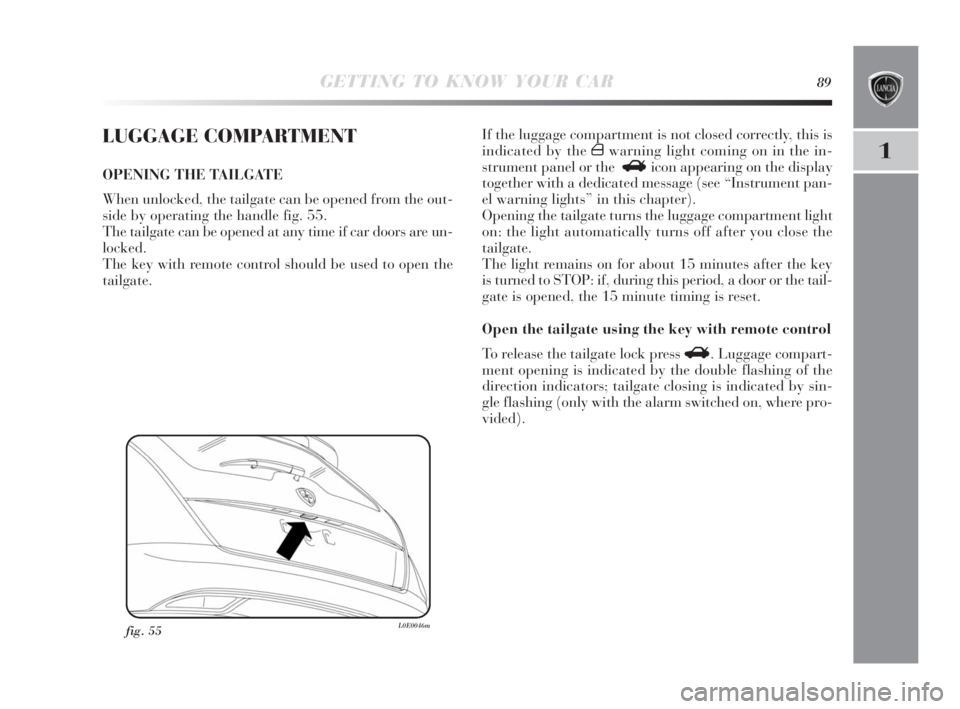
GETTING TO KNOW YOUR CAR89
1
LUGGAGE COMPARTMENT
OPENING THE TAILGATE
When unlocked, the tailgate can be opened from the out-
side by operating the handle fig. 55.
The tailgate can be opened at any time if car doors are un-
locked.
The key with remote control should be used to open the
tailgate.
fig. 55L0E0046m
If the luggage compartment is not closed correctly, this is
indicated by the
´warning light coming on in the in-
strument panel or the
Ricon appearing on the display
together with a dedicated message (see “Instrument pan-
el warning lights” in this chapter).
Opening the tailgate turns the luggage compartment light
on: the light automatically turns off after you close the
tailgate.
The light remains on for about 15 minutes after the key
is turned to STOP: if, during this period, a door or the tail-
gate is opened, the 15 minute timing is reset.
Open the tailgate using the key with remote control
To release the tailgate lock press R. Luggage compart-
ment opening is indicated by the double flashing of the
direction indicators; tailgate closing is indicated by sin-
gle flashing (only with the alarm switched on, where pro-
vided).
001-142 Delta 3ed gb 30-11-2009 11:22 Pagina 89
Page 102 of 276
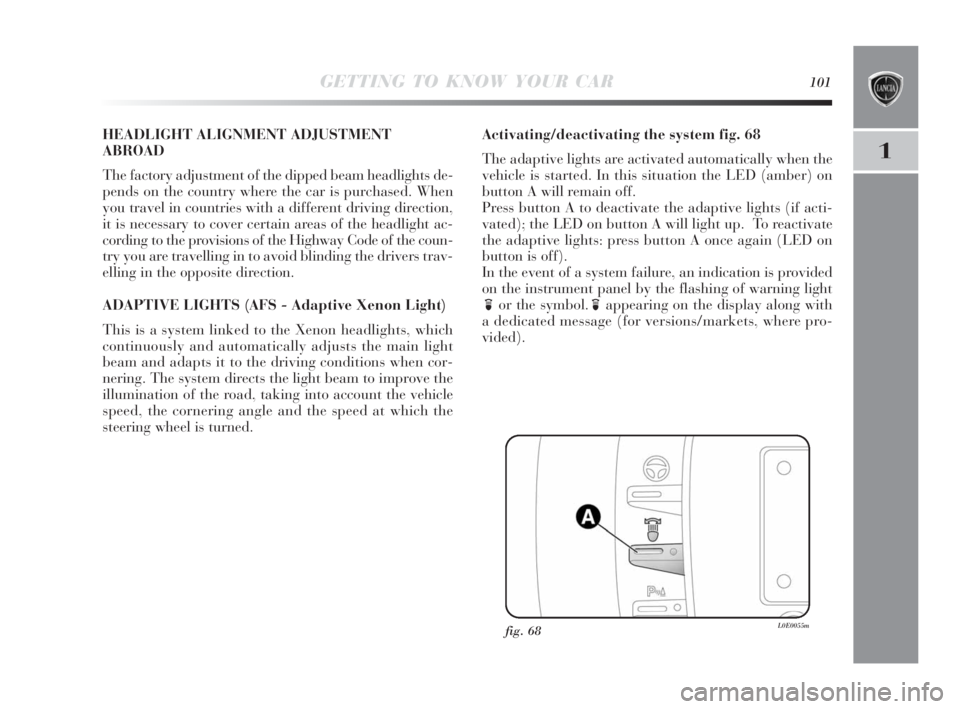
GETTING TO KNOW YOUR CAR101
1
HEADLIGHT ALIGNMENT ADJUSTMENT
ABROAD
The factory adjustment of the dipped beam headlights de-
pends on the country where the car is purchased. When
you travel in countries with a different driving direction,
it is necessary to cover certain areas of the headlight ac-
cording to the provisions of the Highway Code of the coun-
try you are travelling in to avoid blinding the drivers trav-
elling in the opposite direction.
ADAPTIVE LIGHTS (AFS - Adaptive Xenon Light)
This is a system linked to the Xenon headlights, which
continuously and automatically adjusts the main light
beam and adapts it to the driving conditions when cor-
nering. The system directs the light beam to improve the
illumination of the road, taking into account the vehicle
speed, the cornering angle and the speed at which the
steering wheel is turned.Activating/deactivating the system fig. 68
The adaptive lights are activated automatically when the
vehicle is started. In this situation the LED (amber) on
button A will remain off.
Press button A to deactivate the adaptive lights (if acti-
vated); the LED on button A will light up. To reactivate
the adaptive lights: press button A once again (LED on
button is off).
In the event of a system failure, an indication is provided
on the instrument panel by the flashing of warning light
for the symbol.
fappearing on the display along with
a dedicated message (for versions/markets, where pro-
vided).
fig. 68L0E0055m
001-142 Delta 3ed gb 30-11-2009 11:22 Pagina 101
Page 105 of 276

104GETTING TO KNOW YOUR CAR
REACTIVE SUSPENSION
SYSTEM
This system interacts with the Sport function (see chap-
ter “1” in “Sport function”).
The SPORT button, fig. 70, can be used to select two dri-
ving settings depending on the type of route and the road
surface:
– with the button released: “normal” mode;
– with the button pressed: SPORT mode.In the “normal” operating mode the active shock absorbers
regulate the vehicle damping, adapting it to the type of
road and the driving stressed considerably improving dri-
ving comfort especially on unmade roads.
When the SPORT function is activatee, the letter “S” is lit
up in the instrument panel. This function produces a sports
driving setting featuring greater responsiveness during ac-
celeration and a sports driving feeling with the steering,
as well as the regulation and distribution of the damping
at the shock absorbers guaranteeing greater vehicle pre-
cision and reaction, whilst maintaining a good level of
comfort. The driver will notice that the vehicle is more
precise when entering bends and quicker in changing di-
rection.
fig. 70L0E0058m
001-142 Delta 3ed gb 30-11-2009 11:22 Pagina 104
Page 106 of 276

GETTING TO KNOW YOUR CAR105
1
On the 1.4 Turbo Jet 150 HP version, when the SPORT
button is pressed, the turbocharger (overboost) function
is also activated; the engine management control unit, de-
pending on the
position of the accelerator pedal and, for a limited time,
allows maximum pressure leves inside the turbocharger
to be reached with a consequent increase in engine torque
compared with that that can be reached normally.
This function is particularly useful if maximum perfor-
mance is required for a short period (e.g. when overtak-
ing).
IMPORTANT When the SPORT function is used, during
acceleration shuddering of the steering may be noticed
which is typical of a sports setting.
IMPORTANT The function is activated about 5 seconds
after the SPORT button is pressed.
System failure
In the case of fault, the system notifies the driver by means
of a message on the reconfigurable multifunctional display
instrument panel and by lighting up the amber symbol
i.
In this case, go to a Lancia Dealership.
DRIVING ADVISOR
(for versions/markets, where provided)
The Driving Advisor is a warning system that notifies
the driver if they drift out of their lane because they have
been distracted.
A video sensor, fitted to the windscreen near the internal
rear-view mirror, detects the lane boundaries and the ve-
hicle’s position in respect to them.
IMPORTANT If the windscreen needs replacing on cars
fitted with a Driving Advisor system, it is advisable to go
to a Lancia Dealership. If the repair is being carried out
at a specialist window replacement centre, it is still nec-
essary to go to a Lancia Dealership to have the tv cam-
era calibrated.
001-142 Delta 3ed gb 30-11-2009 11:22 Pagina 105
Page 108 of 276

GETTING TO KNOW YOUR CAR107
1
SWITCHING OFF THE SYSTEM
Manual method
The system can be deactivated by pressing button A-fig. 71
on the dashboard.
Confirmation of system deactivation is signalled by the
LED on the button going out and a message 1-fig. 72 ap-
pearing on the display.
Automatic method
The system can be deactivated automatically (if the sys-
tem is required it will therefore need to be reactivated).
The driver is advised that the system has been turned off au-
tomatically by three consecutive acoustic signals and the mes-
sage 1 – fig. 72 in the instrument panel display after the fol-
lowing situations:
❍the driver does not keep his hands on the steering wheel
(indication 2-fig. 72 is shown on the instrument pan-
el and a buzzer sounds until the driver places his hands
back on the wheel. This is considered a dangerous con-
dition and the system is automatically deactivated);
❍triggering of the vehicle safety systems (ABS, ESP,
ASR, DST and TTC);
❍the driver sets the sports driving pressing the SPORT
button (for versions/markets, where provided).
WARNING: the system cannot be activated if the driver
has previously selected the sport driving mode. The im-
possibility of using the system will be communicated to
the driver by three consecutive beeps and by the displayed
message 1 in fig. 72.SYSTEM FAILURE
In the event of a malfunction, the system reports the fault
via a message 3-fig. 72 appearing on the display and a
buzzer sounding.
IMPORTANT
The driving advisor is unable to operate following a malfunc-
tion in any of the following safety systems: ABS, ESP, ASR,
DST and TTC.
In the presence of indistinct, overlapping or
missing lane markings, the lane assistance
function is unable to aid the driver and the
system will be deactivated.
The driving advisor is not an automatic dri-
ving system and cannot replace the driver in
controlling the vehicle trajectory. The driver
is personally responsible for maintaining a suitable
level of concentration as traffic and road conditions
require, and for safely controlling the vehicle’s tra-
jectory.
The operation of the lane assistance function may be com-
promised by adverse visibility conditions (rain, fog, snow),
extreme lighting conditions (solar glare, darkness) or dirt
or damage, even partial, to the windscreen in the area
around the video camera.
The area of the windscreen by the TV camera should not
be partly or totally obscured by objects (e.g. stickers, pro-
tective film, etc.)
001-142 Delta 3ed gb 30-11-2009 13:22 Pagina 107
Page 111 of 276
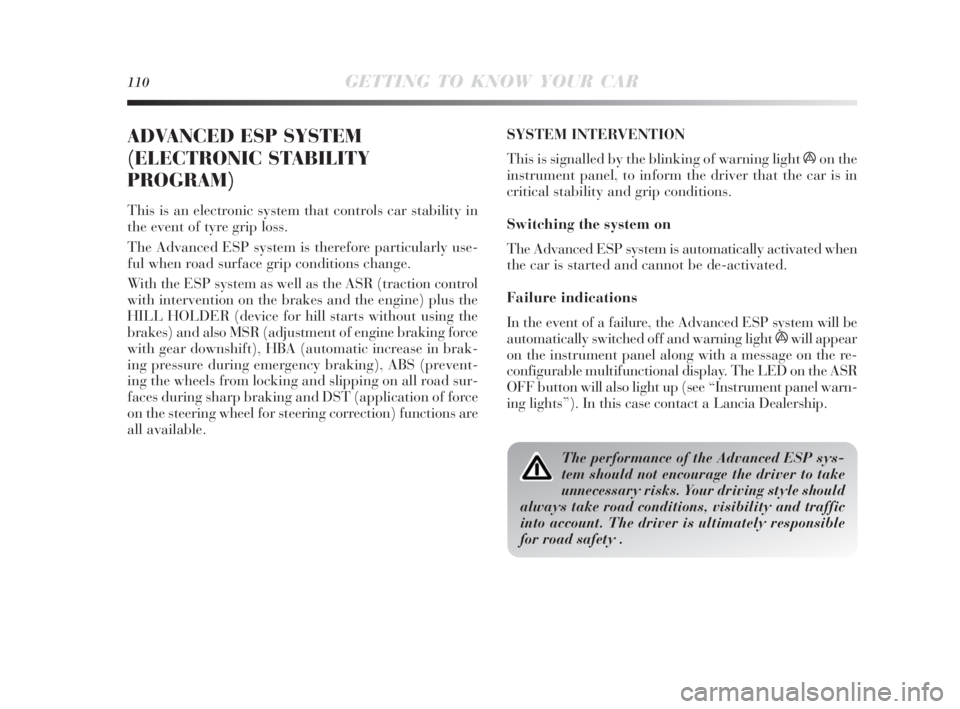
110GETTING TO KNOW YOUR CAR
ADVANCED ESP SYSTEM
(ELECTRONIC STABILITY
PROGRAM)
This is an electronic system that controls car stability in
the event of tyre grip loss.
The Advanced ESP system is therefore particularly use-
ful when road surface grip conditions change.
With the ESP system as well as the ASR (traction control
with intervention on the brakes and the engine) plus the
HILL HOLDER (device for hill starts without using the
brakes) and also MSR (adjustment of engine braking force
with gear downshift), HBA (automatic increase in brak-
ing pressure during emergency braking), ABS (prevent-
ing the wheels from locking and slipping on all road sur-
faces during sharp braking and DST (application of force
on the steering wheel for steering correction) functions are
all available.SYSTEM INTERVENTION
This is signalled by the blinking of warning light áon the
instrument panel, to inform the driver that the car is in
critical stability and grip conditions.
Switching the system on
The Advanced ESP system is automatically activated when
the car is started and cannot be de-activated.
Failure indications
In the event of a failure, the Advanced ESP system will be
automatically switched off and warning light áwill appear
on the instrument panel along with a message on the re-
configurable multifunctional display. The LED on the ASR
OFF button will also light up (see “Instrument panel warn-
ing lights”). In this case contact a Lancia Dealership.
The performance of the Advanced ESP sys-
tem should not encourage the driver to take
unnecessary risks. Your driving style should
always take road conditions, visibility and traffic
into account. The driver is ultimately responsible
for road safety .
001-142 Delta 3ed gb 30-11-2009 11:22 Pagina 110